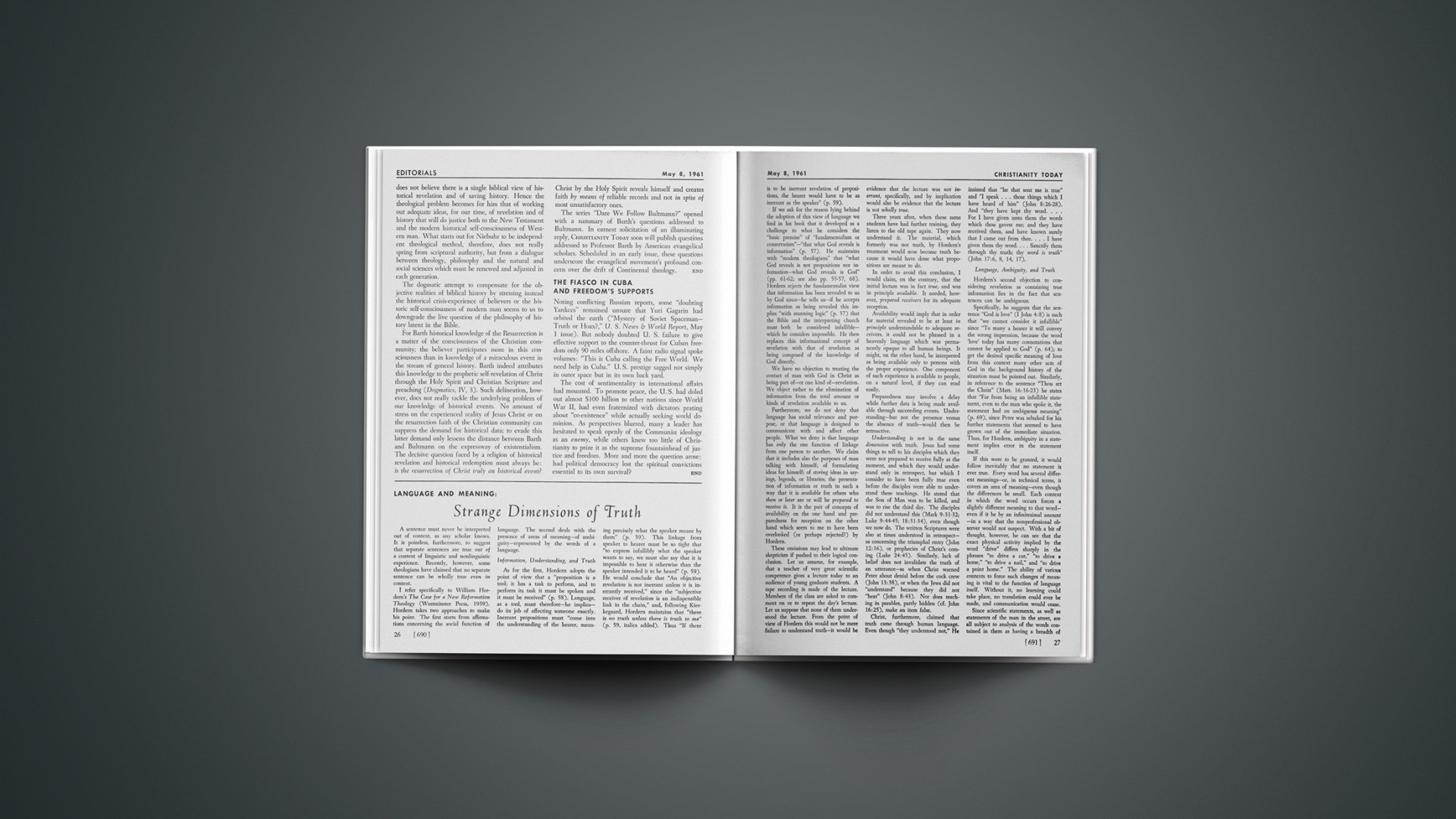A sentence must never be interpreted out of context, as any scholar knows. It is pointless, furthermore, to suggest that separate sentences are true out of a context of linguistic and nonlinguistic experience. Recently, however, some theologians have claimed that no separate sentence can be wholly true even in context.
I refer specifically to William Hordern’s The Case for a New Reformation Theology (Westminster Press, 1959). Hordern takes two approaches to make his point. The first starts from affirmations concerning the social function of language. The second deals with the presence of areas of meaning—of ambiguity—represented by the words of a language.
Information, Understanding, and Truth
As for the first, Hordern adopts the point of view that a “proposition is a tool; it has a task to perform, and to perform its task it must be spoken and it must be received” (p. 58). Language, as a tool, must therefore—he implies—do its job of affecting someone exactly. Inerrant propositions must “come into the understanding of the hearer, meaning precisely what the speaker meant by them” (p. 59). This linkage from speaker to hearer must be so tight that “to express infallibly what the speaker wants to say, we must also say that it is impossible to hear it otherwise than the speaker intended it to be heard” (p. 59). He would conclude that “An objective revelation is not inerrant unless it is inerrantly received,” since the “subjective receiver of revelation is an indispensible link in the chain,” and, following Kierkegaard, Hordern maintains that “there is no truth unless there is truth to me” (p. 59, italics added). Thus “If there is to be inerrant revelation of propositions, the hearer would have to be as inerrant as the speaker” (p. 59).
If we ask for the reason lying behind the adoption of this view of language we find in his book that it developed as a challenge to what he considers the “basic premise” of “fundamentalism or conservatism”—“that what God reveals is information” (p. 57). He maintains with “modern theologians” that “what God reveals is not propositions nor information—what God reveals is God” (pp. 61–62; see also pp. 55–57, 68). Hordern rejects the fundamentalist view that information has been revealed to us by God since—he tells us—if he accepts information as being revealed this implies “with stunning logic” (p. 57) that the Bible and the interpreting church must both be considered infallible—which he considers impossible. He then replaces this informational concept of revelation with that of revelation as being composed of the knowledge of God directly.
We have no objection to treating the contact of man with God in Christ as being part of—or one kind of—revelation. We object rather to the elimination of information from the total amount or kinds of revelation available to us.
Furthermore, we do not deny that language has social relevance and purpose, or that language is designed to communicate with and affect other people. What we deny is that language has only the one function of linkage from one person to another. We claim that it includes also the purposes of man talking with himself; of formulating ideas for himself; of storing ideas in sayings, legends, or libraries; the presentation of information or truth in such a way that it is available for others who then or later are or will be prepared to receive it. It is the pair of concepts of availability on the one hand and preparedness for reception on the other hand which seem to me to have been overlooked (or perhaps rejected?) by Hordern.
These omissions may lead to ultimate skepticism if pushed to their logical conclusion. Let us assume, for example, that a teacher of very great scientific competence gives a lecture today to an audience of young graduate students. A tape recording is made of the lecture. Members of the class are asked to comment on or to repeat the day’s lecture. Let us suppose that none of them understood the lecture. From the point of view of Hordern this would not be mere failure to understand truth—it would be evidence that the lecture was not inerrant, specifically, and by implication would also be evidence that the lecture is not wholly true.
Three years after, when these same students have had further training, they listen to the old tape again. They now understand it. The material, which formerly was not truth, by Hordern’s treatment would now become truth because it would have done what propositions are meant to do.
In order to avoid this conclusion, I would claim, on the contrary, that the initial lecture was in fact true, and was in principle available. It needed, however, prepared receivers for its adequate reception.
Availability would imply that in order for material revealed to be at least in principle understandable to adequate receivers, it could not be phrased in a heavenly language which was permanently opaque to all human beings. It might, on the other hand, be interpreted as being available only to persons with the proper experience. One component of such experience is available to people, on a natural level, if they can read easily.
Preparedness may involve a delay while further data is being made available through succeeding events. Understanding—but not the presence versus the absence of truth—would then be retroactive.
Understanding is not in the same dimension with truth. Jesus had some things to tell to his disciples which they were not prepared to receive fully at the moment, and which they would understand only in retrospect, but which I consider to have been fully true even before the disciples were able to understand these teachings. He stated that the Son of Man was to be killed, and was to rise the third day. The disciples did not understand this (Mark 9:31–32; Luke 9:44–45; 18:31–34), even though we now do. The written Scriptures were also at times understood in retrospect—as concerning the triumphal entry (John 12:16), or prophecies of Christ’s coming (Luke 24:45). Similarly, lack of belief does not invalidate the truth of an utterance—as when Christ warned Peter about denial before the cock crew (John 13:38), or when the Jews did not “understand” because they did not “hear” (John 8:43). Nor does teaching in parables, partly hidden (cf. John 16:25), make an item false.
Christ, furthermore, claimed that truth came through human language. Even though “they understood not,” He insisted that “he that sent me is true” and “I speak … those things which I have heard of him” (John 8:26–28). And “they have kept thy word.… For I have given unto them the words which thou gavest me; and they have received them, and have known surely that I came out from thee.… I have given them thy word.… Sanctify them through thy truth; thy word is truth” (John 17:6, 8, 14, 17).
Language, Ambiguity, and Truth
Hordern’s second objection to considering revelation as containing true information lies in the fact that sentences can be ambiguous.
Specifically, he suggests that the sentence “God is love” (1 John 4:8) is such that “we cannot consider it infallible” since “To many a hearer it will convey the wrong impression, because the word ‘love’ today has many connotations that cannot be applied to God” (p. 64); to get the desired specific meaning of love from this context many other acts of God in the background history of the situation must be pointed out. Similarly, in reference to the sentence “Thou art the Christ” (Matt. 16:16–23) he states that “Far from being an infallible statement, even to the man who spoke it, the statement had an ambiguous meaning” (p. 69), since Peter was rebuked for his further statements that seemed to have grown out of the immediate situation. Thus, for Hordern, ambiguity in a statement implies error in the statement itself.
If this were to be granted, it would follow inevitably that no statement is ever true. Every word has several different meanings—or, in technical terms, it covers an area of meaning—even though the differences be small. Each context in which the word occurs forces a slightly different meaning to that word—even if it be by an infinitesimal amount—in a way that the nonprofessional observer would not suspect. With a bit of thought, however, he can see that the exact physical activity implied by the word “drive” differs sharply in the phrases “to drive a car,” “to drive a horse,” “to drive a nail,” and “to drive a point home.” The ability of various contexts to force such changes of meaning is vital to the function of language itself. Without it, no learning could take place, no translation could ever be made, and communication would cease.
Since scientific statements, as well as statements of the man in the street, are all subject to analysis of the words contained in them as having a breadth of meaning, it would follow clearly that Hordern has in fact rejected the possibility of any wholly true science. The turn of the wheel is curiously complete. Having, along with the liberals, rejected fundamentalism because it “seemed to require intellectual hari-kari” (cf. p. 108) in its relationships to science, etc. (cf. also pp. 53, 60, 86, 92, 113), Hordern has in fact adopted a position which, in my view, in turn breeds intellectual hari-kari through denying full truth value to any of the statements or summaries or propositions of science.
Dimension of Truth versus Error
We now ask: How can we avoid Hordern’s conclusion that ambiguity implies error? We can do so if we view statements as containing dimensions—as we hinted in the first section of this article.
The first of these dimensions of statement has truth at one pole and error at the other. We have in mind the ordinary meaning of the words true and false: Truth in a statement is based upon information which can be relied upon. Error and falsehood are reports of observation, information, or judgment which cannot be relied upon.
In this view a true statement about weather reflects the measurable facts of humidity, temperature, and so on. A person who operates on the basis of such a report will find himself acting adequately. As Edward J. Carnell says: “The true is the quality of that judgment or proposition which, when followed out into the total witness of facts in our experience, does not disappoint our expectation” (An Introduction to Christian Apologetics, 1956, p. 45).
The Dimension of Magnification
A second dimension of statements differs sharply from the first: We do not wish to apply directly to this characteristic of statements either the term truth or the term error. The contrast referred to is rather a difference which may be called high magnification versus low magnification, using the optical term metaphorically. If we look at a fly under a low-powered magnifying glass we may be able to see the whole fly with considerable detail involved. If we wish to see much more detail about the structure of the fly, we must use a higher-powered microscope. The price we pay for this fine detail, however, is very great—the fly as a whole cannot be seen all at once. The pattern of the fly as a whole has disappeared from view. As others have said, one cannot find a face with a microscope. Similarly, as regards language, if one writes for a beginner an extremely intricate textbook on the laws of physics, including elaborate details, illustrations, reservations, implications, and the like, the beginner cannot adequately get information from the book.
Neither the detailed treatment nor one showing the over-all pattern should be called true as such, and neither should be called false as such. Truth and error may both be found at each pole of this kind of contrast. A detailed statement may be true or it may be false. Degree of detail in a statement is not of itself either true or false.
Language is adequate to accomplish the aim of communicating information at any level of magnification. One must not, however, demand that simultaneously both exhaustive detail and general pattern must always be presented. It is only God who is able to grasp simultaneously ultimate pattern and infinite detail.
The Bible, in general, chooses to have a low amplification in order to have a high concentration of meaningful pattern present.
No scientific statement, on the other hand, can ever reach an ultimate degree of magnification. If one wishes to claim that a true statement must have the highest magnification, then no scientific statement can ever be true—there is always more detail possible. To equate truth with magnification is to abandon scientific discourse.
The Dimension of Relevance
Degrees of relevance lead to a third dimension of statement.
Contextual resolution of ambiguity can be viewed in this light. Contexts cause changes in the meanings of words, as we indicated above, but they also force the hearer’s selection of those specific meanings which are relevant to the intention of the writer. In the phrase “to drive a nail” one cannot rationally assume that the writer means “to control the direction of movement of a nail by moving it with reins.” Context provided by a sentence, therefore, can—and often does—eliminate the irrelevant ambiguity inherent in an isolated word. Context provided by a paragraph—or a whole book—can also eliminate ambiguities inherent in isolated sentences. The sentence “God is love,” interpreted in the context of the Bible, is narrowed in the possible range of its meanings. Language, by context, is adequate to portray truth by using words each of which by itself would be ambiguous.
The technique by which language carries out its business of selecting specific, relevant, components out of multiple-available components has reference to the way in which words in context influence one another. The process is extremely powerful. Without it, no language could ultimately function, even though the process is not yet too well understood. (Compare Robert E. Long-acre, “Items in Context: Their Bearing on Translation Theory,” in Language, 34.482–91, 1958.)
Sharpness of focus on some one relevant part of the meaning of a word (or sentence) can always be increased if one chooses. Sharpness is often achieved at the cost of more words, by a longer explanation. Yet, relevance is not magnification. Technical formulas, such as those of symbolic logic, have a kind of precision achieved by brevity, not amplification, since irrelevant words are pruned away. An artistically sharp-cut verbal sketch of a situation may make clear more effectively those parts of a person’s character relevant to the author’s interest than can a rambling ten-year diary.
We must keep truth tied to the power of language to reveal relevant pattern rather than tying truth to an unattainable infinity of irrelevant detail. One might assume that a story could be told with all details made explicit. This is impossible. The hare could then never catch the tortoise. Billions of molecular details would have to be specified, the story would stop, communication would cease, and truth could not exist in any way known to us now. Problems of round numbers, summaries of sermons, the use of “son” in the sense of “descendant,” and so on, take place in a perspective of the nature of language as adequate for truly communicating relevant information—relevant on different levels of magnification.
Can any statement then be true? According to Hordern, as the logic of his position would seem to me to lead him on, the answer must be “No.” According to my view of the nature of language, the answer must be “Yes.”
I end, not with proof, but with a statement of one component of my personal faith: Fruitful discourse in science or theology requires us to believe that within the contexts of normal discourse there are some true statements. Man must, sometimes, act as if he believed it—or die.
Professor of Linguistics
University of Michigan
Ann Arbor, Michigan










